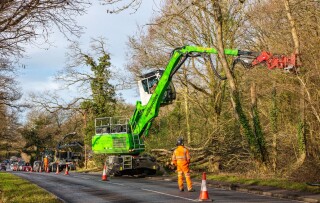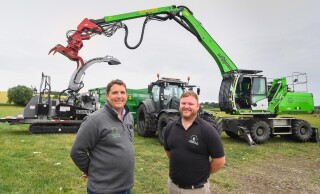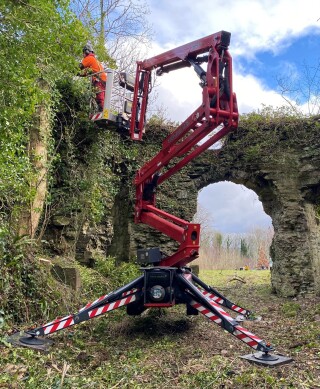UK’s woodlands are undergoing a seismic change. The ash dieback fungus, hymenoscyphus fraxineus, was first detected on these shores in 2012 and it is now widespread.
According to the Woodland Trust, ash dieback, also known as Chalara, will kill around 80% of ash trees across the country – and ash trees make up 12% of Great Britain’s broadleaved woodland. So that’s roughly 10% of woodlands done for. Nothing can be done except clear up.
The fungus originated in Asia and as the Woodland Trust explains: “It doesn’t cause much damage on its native hosts of the Manchurian ash (fraxinus mandshurica) and the Chinese ash (fraxinus chinensis) in its native range. However, its introduction to Europe has devastated the European ash (Fraxinus excelsior) because our native ash species did not evolve with the fungus and so has no natural defence against it.”
Arboriculturists have rarely been so busy, and many are investing in specialist machinery to cope with demand.
PB Forestry & Landscaping Ltd, based in Flecknoe, near Rugby, has invested £1m in specialist tree clearance kit, including a Sennebogen 718e log handler (pictured above), a bespoke bit of kit that allows the firm to cut and remove trees more efficiently, safely and quickly.
The company has further expanded its equipment line with Bandit 20XP and Kesla C645T2 chippers, enabling arisings to be processed and extracted more easily.
Managing director Philip Bett (pictured below with senior operative Terry Boneham and the new machinery) says: “Diseased trees possess a high risk of collapse, not only posing a risk to public safety, but also to tree surgeons using the traditional rope methods, cherry-pickers/mobile elevated work platforms (MEWPs) and chainsaws.
“The Forest Industry Safety Accord has said it is essential that every effort is made to fell diseased ash trees mechanically and to keep any chainsaw operations to an absolute minimum. The Sennebogen 718e has been identified as the safest solution to do this, both for our clients, workforce, and the public.”
The Sennebogen 718e offers specialist tree handling with options of a grapple saw, tree shear and mulching head, giving a complete range of tree clearance, tree safety and vegetation clearance capabilities.
It is capable of cutting at a reach height of 13 metres thanks to its telescopic boom, and its four-wheeled operation allows it to be legally driven on roads. For longer journeys, it can be easily transported on a low-loader, he says.

The machine’s capabilities were recently tested when PB Forestry & Landscaping had to safely clear the woodland frontage of diseased ash trees at Rough Hill Woods near Studley on behalf of Warwickshire Wildlife Trust.
“This was potentially a challenging roadside job using traditional methods, but the Sennebogen enabled us to carry out the works safely over a five-day period, deploying traffic management systems to operate with a single lane closure to minimise disruption,” Philip Bett says.
Ash dieback is also generating demand for specialist powered access, according to Access Platform Sales (APS), the UK and Ireland distributor for Hinowa spider platforms. Its customers include Morris’s Grounds Maintenance of Rhadyr in Monmouthshire, which has a Hinowa Lightlift 17.75 Performance IIIS spider platform. An early assignment for the machine (shown right) was in the ruins of the medieval Tregrug Castle, near Usk.
“Without it, some of our work on this project would have been impossible to do,” says Tom Morris, director of the business. “We scheduled 15 days to complete it. With the Hinowa, we finished it in eight. It makes that big a difference.”
Morris’s tree surgeons were tasked with removing up to 40 mature ash trees, some more than 80 feet tall, which had been infected and fatally weakened. The trees had been rendered so unstable that they were at imminent risk of falling onto the remains of the castle and it was unsafe to use conventional rope climbing techniques to reach the canopies.
The only alternative was to work from an access platform. Tom Morris had rented Hinowa spider booms before but a job of this scale made an outright purchase more feasible.
With a tracking width of just 790mm, the spider lift could be moved across the uneven ground and through the narrow entranceways into the heart of the medieval ruins to reach the trees that needed to be removed.
The team could position its articulating boom within inches of the castle walls and arches, and place the basket in the safest positions to drop branches without striking the masonry.
Tree surgeon Simon Parsons says: “The Hinowa makes a huge difference. It’s much safer to work from. It’s also made almost all aspects of our tree felling operations much faster. Even where the platform hasn’t had the height to reduce the larger trees, we used it to get up into trees to attach a rope and pulley system to guide the tree down as we felled it, saving us a lot of time.”
Tom Morris says: “Ash dieback alone is going to keep the spider platform busy. The disease began to appear in our area around three years ago. Now up to half our jobs involve working on trees affected by ash dieback.”




